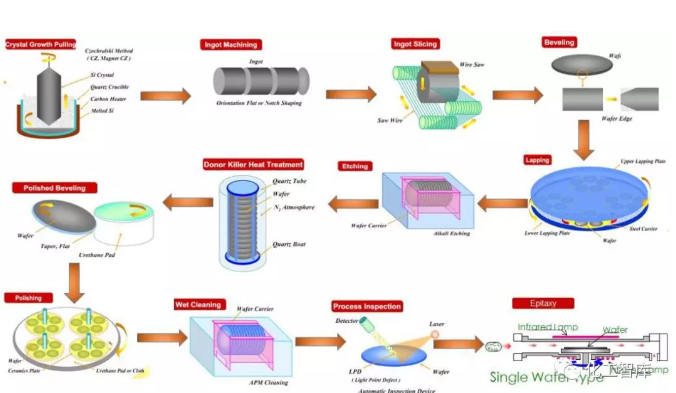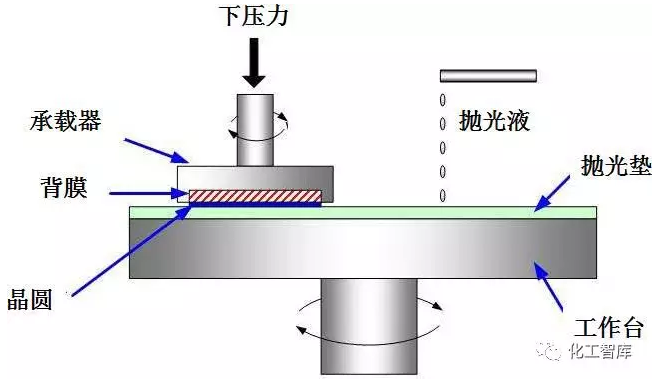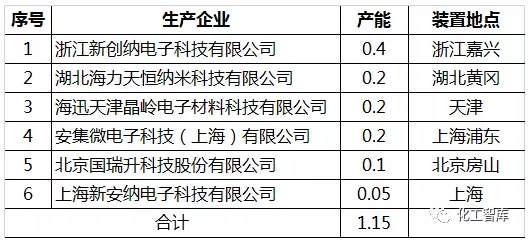Chemical mechanical polishing, abbreviated as CMP, has now become a recognized nano-scale global planarization precision ultra-precision machining technology. It is one of the most important aspects of the semiconductor manufacturing process. Figure 1 Large silicon wafer production process CMP polishing slurry, also known as CMP slurry, polishing liquid, polishing liquid, abrasive material, English name CMP slurry, is one of the three key elements of CMP process. Its performance and mutual matching determine the level of surface level that CMP can achieve. Polishing paste is a consumable and requires recycling. Depending on the abrasive particles, the CMP slurry is mainly classified into several types such as silica slurry, cerium oxide slurry, alumina slurry and nano-diamond slurry. Classified by pH, polishing slurries fall into two main categories: acidic polishing slurries and alkaline polishing slurries. Generally, the acidic polishing slurry contains an oxidizing agent, a co-oxidizing agent, a resist (also referred to as a film forming agent), a leveling agent, a pH adjusting agent, and an abrasive. The alkaline polishing slurry generally contains a complexing agent, an oxidizing agent, a dispersing agent, a pH adjusting agent, and an abrasive. The polishing slurry is generally composed of an ultrafine solid particle abrasive (such as nano-SiO2, Al2O3 particles, etc.), a surfactant, a stabilizer, an oxidizing agent, etc., the solid particles provide a grinding action, and the chemical oxidizing agent provides a corrosion dissolution effect. CMP polishing slurries typically use spherical nanoscale particles to accelerate resection and optimize polishing quality, such as colloidal SiO2 particles, altering the rheological properties of the polishing slurry, and micropolarity can be used to characterize the rheological properties of such fluids. During the CMP process, the chemical components in the polishing slurry react with the workpiece to form a thin, weakly bonded product on the workpiece surface; while the abrasive particles in the polishing slurry are pressed against the workpiece under pressure and friction. The surface is subjected to trace removal. Figure 2 CMP working principle At present, the global semiconductor polishing slurry market is dominated by US, Japanese, and Korean companies, including Japan's Fujimi, Hinomoto Kenmazai, American Cabot, DuPont, Rodel, Eka, and South Korea's ACE. These companies occupy 90% of the world. More than % of the high-end market share. According to SEMI statistics, the global sales of semiconductor materials in 2017 amounted to 46.9 billion US dollars, of which CMP slurry was about 1.31 billion US dollars. Chinese enterprises started late in the field of chemical mechanical polishing. At present, there is still a big gap between them and the international advanced level. There are a few domestic enterprises that use 3M technology to produce small and medium-end products, but lack independent intellectual property rights and brands. The domestic market is completely monopolized by foreign products. The low-end field of CMP slurry in China has been domestically produced, but semiconductor CMP slurry is basically dependent on imports. Domestic enterprises such as Tianjin Jingling and Anyang Fangyuan, etc., are mainly used for polishing glass covers such as mobile phone covers, and are relatively reluctant for wafer polishing. Due to the high technical requirements of the chip polishing slurry, the formula is completely confidential. Only a few companies in China have mastered some low-end technologies, such as Anji, Guoruisheng and Xinanna, so the CMP slurry in the high-end fields such as chips has been Dependent on imports. In 2017, China's semiconductor CMP slurry added 6,000 tons / year of production capacity, respectively, Zhejiang Xinchuangna Electronic Technology Co., Ltd. 4000 tons / year, Hubei Haili Tianheng Nano Technology Co., Ltd. 2000 tons / year, the national total capacity reached 1.15 10,000 tons / year. 2017 China's semiconductor CMP slurry main production enterprises Unit: tons / year Hubei Dinglong Holdings Co., Ltd. is in the preliminary work of CMP slurry and is expected to achieve industrialization results in the next few years. Shanghai Xinanna Electronic Technology Co., Ltd. conducted an environmental impact assessment of a 4000-ton/year electronic grade silica polishing fluid production project in 2016. The formulation of CMP slurry is very important. Once China breaks through, production will develop rapidly and the operating rate will increase. It is estimated that China's CMP slurry production capacity will reach 40,000 tons per year in 2022. According to the preliminary investigation of China Chemical Industry and Technology Development Center, the apparent consumption of CMP slurry in China was about 47,800 tons in 2017, and the external dependence rate was 87.4%. The average annual growth rate will be around 10% in the next few years. The CMP slurry for semiconductors mainly has a silica slurry and a cerium oxide slurry. The preparation method of the silica polishing slurry is mainly a dispersion method and a coacervation method. (1) The dispersion method is a method of preparing a silica slurry by directly dispersing nanosilica powder (fumed silica) in water by mechanical stirring. First, the nano-silica particles are wetted in the liquid; the agglomerates are opened into independent primary particles or smaller agglomerates under mechanical agitation; the primary particles or smaller agglomerates are stabilized to prevent re-agglomeration . The Si Qiqi slurry prepared by the dispersion method has high concentration, uniform particle size, good dispersibility, high purity and low viscosity, but it is particularly affected by the performance of the powder itself. (2) The coacervation method is a method for obtaining a nano-silica water dispersion system by nucleating and growing by using a silica formed by a chemical reaction in an aqueous solution, and removing the impurity ions therein by various methods. The silica slurry particles have uniform particle size, regular shape, and high purity and concentration. The disadvantage of this method is that a chemical reaction is required. "China's semiconductor output value accounts for about one-fifth of the world's total output value, and it maintains a rapid growth trend. However, China's key materials are almost blank, which makes China's semiconductors and its more sophisticated industries have huge risks. At present, China's semiconductor CMP The external dependence rate of slurry is 87.4%, which is also a product that is highly dependent on externally. Polishing slurry is the core and value core of CMP technology, with high technical barriers and long certification time. It is a product that China must develop its own technology and industry. Customized Vision Lite Frame,Customized Vision Lite Kits,Customized Stainless Steel Stamping Part,Customized Aluminum Stamping Part MGX Metalworks Co., Ltd. , https://www.mgxmetal.com


CNCET Industry Research: CMP slurry for semiconductors
Abstract Chemical mechanical polishing, abbreviated as CMP, has become a recognized nano-scale global flat precision ultra-precision machining technology. It is one of the most important aspects of the semiconductor manufacturing process. Figure 1 large silicon wafer production process CMP polishing slurry, also known as CMP slurry, polishing fluid, polishing fluid...